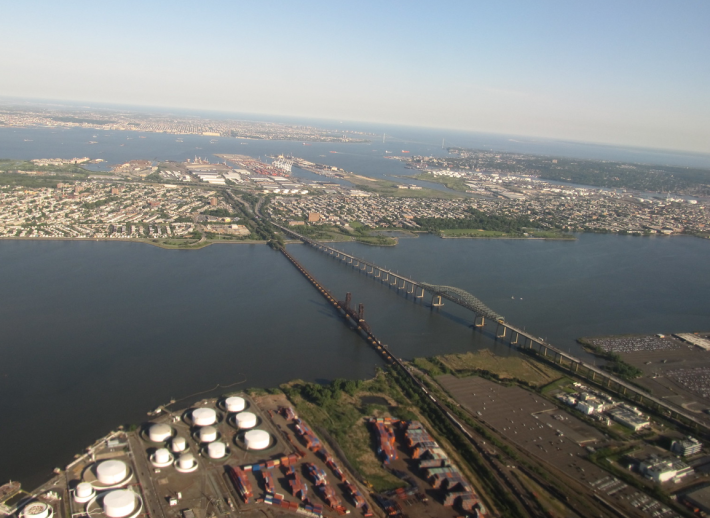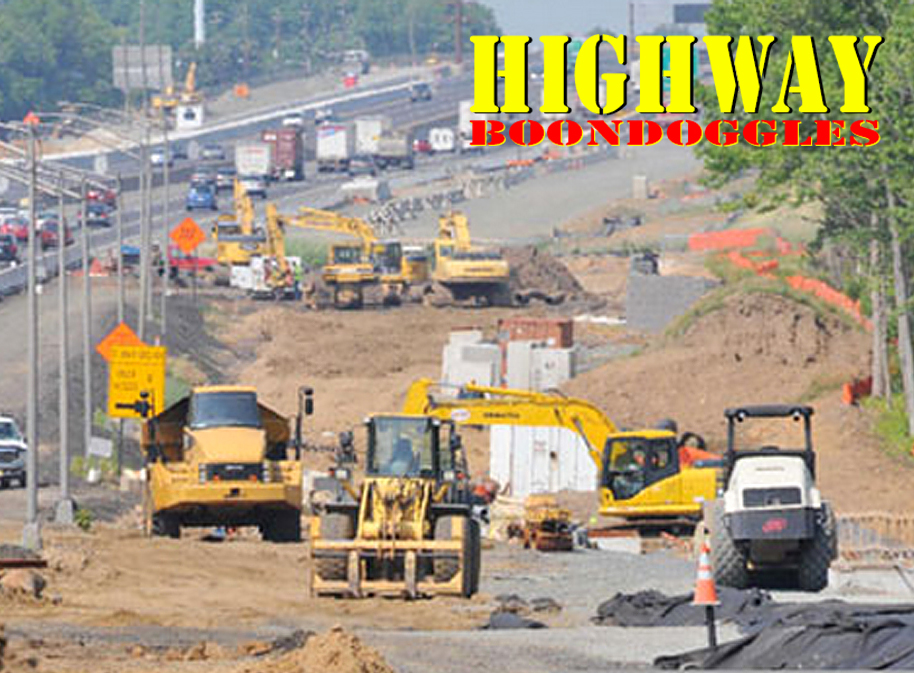This article is a part of our annual Highway Boondoggles series, in partnership with U.S. PIRG. This series will explore some of the worst planned highway projects across the country, and explore why they deserve to be cancelled — and why U.S. transportation policy must be reformed to discourage similar initiatives in the future. The entire series is archived here. You can also view the full report now. Today, we focus on a Garden State flimflam.
N.J. Turnpike and Garden State Parkway widening
Cost: $16 billion+
Since it opened in 1951, the New Jersey Turnpike has undergone a seemingly endless series of expansion projects, beginning just four years into its existence when unanticipated traffic volumes prompted the New Jersey Turnpike Authority to add a raft of new lanes along an 83-mile stretch of the roadway. Seven decades on, with the Turnpike now among the most traveled highways in the country, various sections have been widened to six, 12, and even as many as 14 lanes.
The more lightly traveled stretch between Exit 1 and Exit 4 between the southern terminus and Mount Laurel Township, however, has remained the original four-lane road. In March 2021, the authority awarded a $48-million professional services contract to infrastructure consulting firm AECOM to conduct the initial environmental studies and permitting for an expansion of this 34-mile stretch of the turnpike. Based on recommendations, the planned construction will add a new lane in each direction between Exits 1 and 4, at a cost of approximately $1.1 billion.
Construction on the Interchange 1 to 4 Widening Program is due to begin in 2025. In addition to the new lanes, the work is set to include “geometric and capacity improvements” at all of the interchanges along this corridor, as well as potentially the addition of a new interchange “to help alleviate congestion on the local roadway network,” and a range of other infrastructure upgrades.
The Interchange 1 to 4 Widening Program is one of 14 expansion projects planned for the New Jersey Turnpike and the Garden State Parkway under a $24-billion capital program announced by the turnpike authority in 2020, which includes more than $16 billion in expansion projects. Elsewhere on the Turnpike, the program includes a now-$4.7-billion project for the Turnpike Extension between Exits 14 and 14A, and doubling the number of lanes from two to four in each direction on a three-mile section of the roadway crossing Newark Bay, involving the construction of a new eight-lane bridge and the replacement or widening of three existing ones.
Other projects include:
- the $1.35-billion widening of 27 miles of the Garden State Parkway between interchanges 98 and 125 from five or six lanes to six or seven lanes in each direction.
- the addition of two new lanes in each direction along 12 miles of the parkway between interchanges 142 and 154, at a cost of $2.5 billion.
In total, these 14 projects in the program would see approximately 100 miles of roadway widened, and the addition of at least 454 lane miles.
Noting the growth in population and traffic volume along the Turnpike’s interchange 1 to 4 corridor, turnpike authority argues that “the addition of an additional lane in each direction will advance mobility, improve safety, reduce congestion and thereby improve air quality across the Program Corridor.” In reality, an analysis by New Jersey Sierra Club estimates that these projects will increase capacity by at least 998,800 cars per hour during peak times.

Adding this kind of capacity to New Jersey’s highways is a needless, self-imposed impediment to achieving the state’s mandated goal of 80 percent climate pollutant reductions by 2050 and the goal of Executive Order 274 from November 2021 to cut New Jersey’s climate pollution by 50 percent below 2006 levels by 2030. It also runs directly counter to the Murphy administration’s 2020 Energy Master Plan, which asserts the need for a “concerted effort to reduce vehicle miles traveled,” and “reducing reliance on passenger vehicles — particularly single passenger — and increasing the use of mass transportation.”
Every dollar spent on road expansion is a dollar that could be spent on the very initiatives the Energy Master Plan describes as essential in addressing the climate and health impacts of transportation emissions, including expansion of multimodal travel options, Complete Streets initiatives and other programs conducive to “connecting people to transit and getting more cars off the road,” as well as much needed investment in New Jersey Transit’s capital budget and electric bus transformation, NorthJersey.com reported.
Gov. Murphy’s Energy Master Plan notes that New Jersey’s transportation sector already accounts for 42 percent of the state’s total climate emissions – well above the national average of 27 percent. The Plan also states that mobile sources are the state’s leading cause of ozone precursors and responsible for more than 70 percent of nitrogen oxide (NOx) emissions, and that all 21 counties in New Jersey are in “moderate or marginal non-attainment” of ground-level ozone standards.
Six counties received F grades for ground-level ozone in the American Lung Association’s 2022 State of the Air report. Emissions reductions on the scale that New Jersey has set for itself and mandated into law were always going to be ambitious, but continuing to invest in the very things that contribute most to perpetuating and exacerbating the problem, even as the state spends billions elsewhere trying to fix it, is only going to push that goal ever further out of reach.






